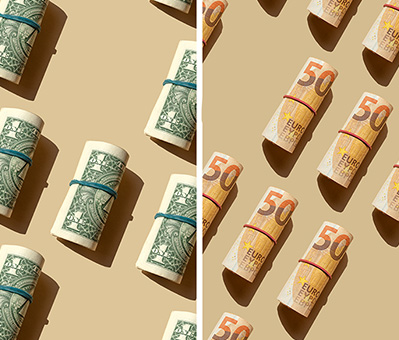

- Severe liquidity shortages in the USD credit market occurred during the peak of the COVID-19 crisis last March, creating large discrepancies in corporate-bond spreads between USD and EUR markets.
- The Federal Reserve’s bond-purchase program appears to have significantly restored liquidity, but persistent smaller discrepancies in spreads across currencies existed both before and after the crisis period.
- The corporate-bond cross-currency spread is a source of risk for investors, but may also be an opportunity.
Intuitively, an issuer’s credit spread should be consistent when measured in the USD- or EUR-denominated markets, because both are measuring the same credit risk.1 In practice, divergence can occur as a result of liquidity or supply-demand imbalances. Last March, the COVID-19 crisis led to an acute shortage of liquidity in the USD market, which caused credit spreads in the USD market to spike relative to those in EUR, as shown in the exhibit below. At the peak of the crisis, the average spread on USD-denominated debt was up to 100 basis points (bps) wider than the spread on EUR debt for bonds from the same issuers.2
The Federal Reserve responded by announcing programs to purchase USD-denominated corporate bonds from U.S. companies, which helped restore liquidity and bring the spreads between USD and EUR markets more in line. At the same time, smaller divergences between USD and EUR spreads existed both before and after the crisis period. This cross-currency spread could be both a hidden source of risk and an opportunity for investors.
USD Credit Spreads Widened More than EUR Spreads During the Crisis
For each currency market, spreads were calculated as the difference between the issuer’s yield curve and the riskless yield curve for that market. The spread is computed over the Treasury curve for USD bonds, and over the German-bund curve for EUR bonds. Source: MSCI Credit Curves
The table below lists the largest foreign-currency issuers in our sample.
Largest Nondomestic-Currency Bond Issuers (Eurozone and US)
| Largest Eurozone-Based USD Issuers | Largest US-Based EUR Issuers |
| Telecom Italia S.p.A. | Morgan Stanley |
| Fiat Chrysler Automobiles N.V. | Microsoft Corp. |
| Crédit Agricole | General Electric Co. |
| Danone S.A. | Bank of America Corp. |
| Sanofi S.A. | The Goldman Sachs Group Inc. |
| Électricité de France S.A. | Netflix Inc. |
| ABN AMRO Bank N.V. | Apple Inc. |
| Société Générale | Citigroup Inc. |
| Bank of China Ltd. (Luxembourg) | AT&T Inc. |
| Commerzbank AG | International Business Machines Corp. |
Issuer size is based on the bond amount outstanding used to construct the curves underlying the computation of the cross-currency spread.
What Drove the Spread Differential?
A natural question is whether the spread differential was present for issuers, or just a subset of them. We find that bonds issued by U.S. companies experienced much larger spread differentials than did those by eurozone companies, as the exhibit below shows.3 Following the peak of the COVID-19 crisis’s impact on financial markets, U.S. companies’ USD debt traded at average spreads between 20 and 40 bps tighter than the same company’s debt in EUR. For U.S. companies, this suggests demand was stronger for their USD-denominated debt than their EUR debt. For eurozone companies, on the other hand, demand for their USD and EUR debt appears to have been more balanced, meaning that investors in eurozone companies’ debt were more currency-neutral than investors in U.S.-company debt. This may reflect greater “home bias” among U.S. investors relative to European investors.
US Issuers Drove the Persistent Spread Differential
Issuers
Top 10 Nondomestic-Currency Issuers
Source: MSCI Credit Curves
Cross-Currency Credit Investing: Risks and Opportunities
The persistence of the cross-currency spread suggests risks and opportunities for credit investors. For multicurrency investors, the cross-currency spread may be an additional source of price variability to consider, in addition to an issuer’s intrinsic credit-spread variability. On the other hand, for USD investors willing to hedge or take on foreign-exchange risk, EUR-denominated debt may offer higher yields than USD debt on the same issuers.4 In contrast, there appears to be little cross-currency spread opportunity for EUR investors in the current market environment.5
The authors would like to thank Máté Maródi and Don Stanley for their contributions to this post.
1The cross-currency spread can also arise due to deviations from covered interest-rate parity, or correlation between default and currency devaluation.
For the former, please see: Liao, G. Y. 2020. “Credit Migration and Covered Interest Rate Parity.” Journal of Financial Economics.
For the latter, please see: Ehlers, P. and Schönbucher, P. 2004. “The Influence of FX Risk on Credit Spreads.”
2Treasury yields were also likely inflated due to severe liquidity stress during the peak of the crisis, and may not have been a good measure of riskless borrowing. If so, the true cross-currency spread would have been even wider.
3Drawing a parallel with the sovereign CDS market, we would expect that USD currency devaluation would be positively correlated with issuer default, which would tend to drive the USD-EUR spread positive for U.S. issuers. If so, our result indicates that the spread differential is not caused by correlation between foreign-exchange rates and default, because the USD-EUR spread is negative. (For background on cross-currency spreads in sovereign CDS, see: Manzo, G. and Saret, J. “What Sovereign CDS Spreads Potentially Tell Us About Currency Risk.” Two Sigma.)
4If the cross-currency spread differential is driven purely by FX hedging costs, the spread differential is equal to the deviation from covered interest-rate parity. If we account for this effect, the spread actually widened.
5Note that for both USD and EUR investors, currency hedging involves transaction costs and is not guaranteed to be a perfect hedge, due to cross-currency basis risk.
Further Reading
MSCI Credit Curves (client access only)
Was the Treasury Price Right? Yield Dispersion Amid COVID-19
Bond Liquidity: How Bad Was COVID?
Home bias in fixed income: Has it helped or hurt?


